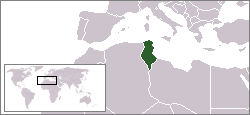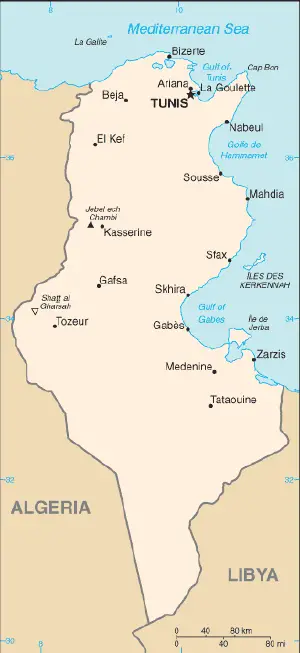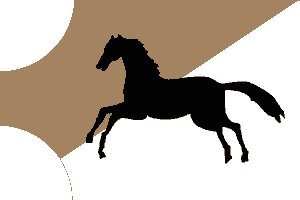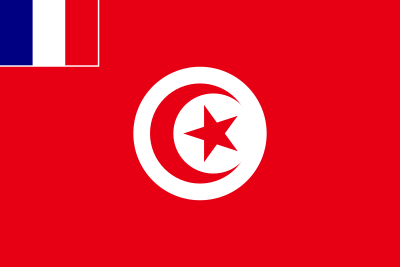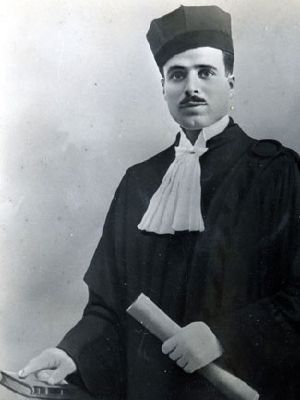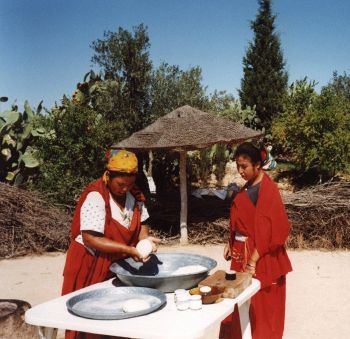Tunisia
| اÙجÙ
ÙÙرÙØ© اÙتÙÙسÙØ© al-JumhÅ«riyyah at-TÅ«nisiyyah Tunisian Republic |
||||||
|---|---|---|---|---|---|---|
|
||||||
| Motto: ØرÙØ©Ø ÙراÙ
Ø©Ø Ø¹Ø¯Ø§ÙØ©Ø ÙظاÙ
"ḤurrÄ«yah, KarÄma, 'AdÄlah, NiáºÄm" "freedom, dignity, justice, and order"[1] |
||||||
| Anthem:Â "Humat al-Hima" "Defenders of the Homeland" |
||||||
| Capital (and largest city) | Tunis 36°50â²N 10°9â²E | |||||
| Official languages | Arabic[2] | |||||
| 1st Foreign language | French | |||||
| Demonym | Tunisian | |||||
| Government | Unitary presidential republic[2] | |||||
| Â -Â | President | Kais Saied | ||||
| Â -Â | Prime Minister | Ahmed Hachani | ||||
| Area | ||||||
|  - | Total | 163,610 km² (92nd) 63,170 sq mi |
||||
|  - | Water (%) | 5.0 | ||||
| Population | ||||||
| Â -Â | 2020Â estimate | 11,976,182[3]Â (81st) | ||||
|  - | Density | 71.65/km² (144th) 186/sq mi |
||||
| GDPÂ (PPP) | 2022Â estimate | |||||
| Â -Â | Total | |||||
| Â -Â | Per capita | |||||
| GDP (nominal) | 2023Â estimate | |||||
| Â -Â | Total | |||||
| Â -Â | Per capita | |||||
| Gini (2015) | 32.8[5] | |||||
| Currency | Tunisian dinar (TND) |
|||||
| Time zone | CET (UTC+1) | |||||
|  - | Summer (DST) | not observed (UTC+1) | ||||
| Internet TLD | .tn .تÙÙسâ[6] | |||||
| Calling code | +216 | |||||
The Tunisian Republic (اÙج٠ÙرÙØ© اÙتÙÙسÙØ©), or Tunisia, with a population of over 10 million, is a predominately Muslim Arab nation situated on the North African Mediterranean Sea coast. It is the easternmost and smallest of the nations situated along the Atlas Mountains, bordering Algeria to the west, and Libya to the south and east.
Forty per cent of the country is comprised of the Sahara Desert, with much of the remainder consisting of particularly fertile soil, with easily accessible coasts. Tunisia played a prominent role in ancient times, first with the famous Phoenician city of Carthage, and later, as the Africa Province, a part of the Roman Empire. Tunisia was known as the bread basket of the Roman Empire.
This nation gained its independence from France in 1956, becoming a republic with a strong presidential system dominated by a single political party until 2011, when then President Zine El Abidine Ben Ali fled during the Tunisian revolution. The interim government dissolved the ruling party and arranged for elections to a Constituent Assembly to be held. The country held its first Presidential elections since the 2011 Arab Spring on November 23, 2014.
A synthesis of various civilizations, having been settled by various peoples, Tunisia is a center of rich cultural activity. Berber, Arab, African, and European influences have shaped the Tunisian cultural identity. The predominant lineage is Berber, with Tunisians regarding themselves as Arabs.
Geography and Environment
Tunisia sits on the Mediterranean coast of North Africa, midway between the Atlantic Ocean and the Nile Valley. It is bordered by Algeria in the west and Libya in the southeast. An abrupt southern turn of its shoreline gives Tunisia two faces on the Mediterranean and marks the division between the eastern and western sections of the Sea. Its coastline is 1,148 kilometers in length. In maritime terms, the country claims a contiguous zone of 24 nautical miles, and a territorial sea of 12 nautical miles.
Despite its relatively small size, Tunisia has great geographical and climactic diversity. It is more mountainous in the north, where the Dorsal, an extension of the Atlas Mountains, traverses Tunisia in a northeasterly direction from the Algerian border in the west to the Cape Bon peninsula. North of the Dorsal is the Tell, a region characterized by low, rolling hills and plains, although in the northwestern corner of Tunisia, the land reaches elevations of 1,050 meters. The Sahil is a plain along Tunisia's eastern Mediterranean coast famous for its olive monoculture. Inland from the Sahil, between the Dorsal and a range of hills south of Gafsa, are the Steppes. Much of the southern region is semi-arid and desert. The Sahara Desert lies in the southernmost part of the country.
The country's climate is temperate in the north, with mild rainy winters and hot, dry summers. The south of the country is desert. The terrain in the north is mountainous, which, moving south, gives way to a hot, dry central plain. The south is semiarid, and merges into the Sahara. A series of salt lakes, known as chotts or shatts, lie in an east-west line at the northern edge of the Sahara, extending from the Gulf of Gabes into Algeria. The lowest point is Chott el Gharsa, at -17 m, and the highest is Jabal ash Shanabi, at 1,544 m.
Natural resources
Tunisia possesses petroleum, phosphates, iron ore, lead, zinc, salt, and arable land. 3,850 km² of land is irrigated in Tunisia.
Concerns
Tunisia has experienced a variety of environmental problems which prompted the country to sign these international environmental agreements: Biodiversity, Climate Change, Desertification, Endangered Species, Environmental Modification, Hazardous Wastes, Law of the Sea, Marine Dumping, Nuclear Test Ban, Ozone Layer Protection, Ship Pollution (MARPOL 73/78) and Wetlands. Tunisia has signed, but not ratified the Marine Life Conservation agreement.
Environmental issues for Tunisia include:
- Toxic and hazardous waste - disposal is ineffective and presents human health risks
- Water pollution from raw sewage
- Limited natural fresh water resources
- Deforestation
- Overgrazing
- Soil erosion
- Desertification
History
It is said that in 814 B.C.E., Carthage was founded by Phoenician settlers led by Queen Elissar Dido, a Pheonician princess of Tyre. Her metropolis rose to be called a "shining city," ruling 300 other cities around the western Mediterranean and leading the Phoenician Punic world.
This area now includes present-day Tunisia. From 700 to 409 B.C.E. there were repeated conflicts between Carthage and Greece over spheres of influence and trade routes. Under the Magonid dynasty the Carthaginians dominated the western Mediterranean, but the Greeks regained the upper hand at the Battle of Imera in 480 B.C.E.. Skirmishes between Greeks and Carthaginians in Sicily spilled over to mainland Tunisia in 311 B.C.E. when the Greeks invaded Cap Bon. Carthage became a major rival to the Roman Republic for the domination of the western Mediterranean Sea in the fourth century B.C.E.. This led to the First Punic War and the Carthaginians loss of Sicily to the Romans. From 218 to 202 B.C.E. the Second Punic War ravaged the region, with Hannibal crossing the Alps to attack Rome. Carthage was eventually destroyed during the Third Punic War, and Tunisia was made part of the Roman Empire. Its citizens were tragically sold into slavery.
In 44 B.C.E. Julius Caesar landed in Tunisia in pursuit of Pompey and Cato the Younger, who had gained the support of the Numidian king Juma I. After Caesar's defeat of the rebels at the The Battle of Thapsus on February 6, 46 B.C.E. near Thapsus (modern Ras Dimas, Tunisia), much of Numidia was annexed by the Romans.
During the first and second century C.E. Carthage was rebuilt under the supervision of Augustus, and new towns were founded, often on the remains of old Punic settlements. This process of development was accelerated after Septimus Severus became the first African emperor of the Roman Empire in 193 C.E..
Early in 238 C.E., local landowners ignited a full-scale revolt in the province. The landowners armed their clients and their agricultural workers and entered Thysdrus, (modern El Djem). Here they murdered the offending official and his bodyguards and proclaimed the aged governor of the province, Gordian I, and his son, Gordian II, as co-emperors. The Senate in Rome switched allegiance, but when the African revolt collapsed under an assault by forces loyal to emperor Maximinus Thrax, (who succeeded the Severus dynasty), the senators elected two more Romans, Pupienus and Balbinus, as co-emperors.
In the year 429 Tunisia was captured by the Vandals, a Germanic people belonging to the family of East Germans, and it became the center of their short-lived kingdom until they were ousted by the Byzantines in 534 C.E..
Middle ages
At the beginning of recorded history, Tunisia was inhabited by Berber tribes who were the descendants of the pre-Arab inhabitants of North African tribes. Its coast was settled by Phoenicians who were traced to the Canaanite tribes recorded in the Bible, dating back as early as the tenth century B.C.E.. In the sixth century B.C.E., Carthage rose to power, but it was conquered by Rome in the ninety-second century B.C.E., and the region became one of the granaries of Rome. It was held by the Vandals in fifth century and Byzantines in sixth century. In the seventh century it was conquered by Arab Muslims, who founded Al Qayrawan. Successive Muslim dynasties ruled, interrupted by Berber rebellions. The Aghlabids, or Arab dynasty in North Africa (Ifriqiya) whose governors were semi-independent of Baghdad, reigned in the ninth and early tenth century.
Zirids from the Petite Kabylie, a faction from the French colonies, ruled along with the Fatimids in the tenth and eleventh centuries. The Fatimids were Berbers who were thought to be descendants of Muhammad's daughter, Fatima, and were especially prosperous. When the Zirids angered the Fatimids in Cairo (1050), the latter sent in the Banu Hilal, Arabs from Arabia, to ravage Tunisia. In 1159, Tunisia was conquered by the Almohads, caliphs of Morocco (1130â1269), who sought to purify Islamic doctrines. [7]
The Almohad Dynasty was succeeded by the Hafsids Dynasty (c.1230â1574), under whom Tunisia prospered. In the last years of the Hafsids, Spain seized many of the coastal cities, but these were recovered for Islam by the Ottoman Empire. The Ottoman Empire was comprised mostly of Turks with governors or Beys, under whom Tunisia attained virtual independence. The Hussein dynasty of Beys, established in 1705, lasted until 1957.
The Barbary Coast
In the late sixteenth century, the coast became a pirate stronghold. The piracy carried on thereafter by the Muslims of North Africa began as part of the wars against Spain. In the seventeenth and eighteenth centuries, when the Turkish hold on the area grew weaker, the raids became less military and more commercial in character. The plunder, ransom, and slaves that resulted from attacks on Mediterranean towns and shipping and from occasional forays into the Atlantic became the main source of revenue for local Muslim rulers.
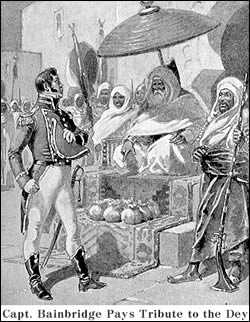
All the major European naval powers made attempts to destroy the corsairs, and British and French fleets repeatedly bombarded the pirate strongholds. Yet, on the whole, countries trading in the Mediterranean found it more convenient to pay tribute than to undertake the expensive task of eliminating piracy.
From 1796, the United States had sent a naval vessel to carry a tribute which the country condescended to pay to the Dey of Algiers, in order to secure exemption from capture of its merchant ships in the Mediterranean Sea. Beginning in the early 1800s a young junior naval officer, William Bainbridge, performed this service punctually, although reportedly with great disgust.
When it was discovered that bribing the pirate Barbary states did not protect their merchant fleet, the United States used force. In command of USS Philadelphia, Bainbridge ran aground on the Tunisian coast on December 29, 1803, and he and his crew were imprisoned by the Dey for more than three years until June 3, 1806.
The first United States military action overseas, executed by the United States Marines and Navy, was the storming of Darnis, Tripoli, in 1805, in an effort to bolster diplomatic efforts in securing both the freedom of American prisoners and putting an end to piracy on the part of the Barbary state.
As the eighteenth century progressed, the power of the piratical states diminished. The United States and the European powers took advantage of this decline to launch more attacks against the pirate states. American opposition resulted in the Tripolitan War. Finally, in 1830, piracy came to an end. On May 12, 1830, Tunisia, was made a French protectorate and in 1956 gained its independence. [8]
Ottoman Empire
The states along the Barbary Coast, Algiers, Morocco, Tripoli, and Tunis, were collectively known as the Barbary States. Apart from Morocco, they were nominally part of the Ottoman Empire.
The Tunisian state was rebuilt by the imposition of Ottoman Empire rule in the late sixteenth century. The Ottomans made Tunisia a province of their empire in 1574, and garrisoned Tunis with 4,000 Janissaries recruited from Anatolia, reinforced by Christian converts to Islam from Italy, Spain, and Provence. In 1591 the local Janissary officers replaced the Sultan's appointee with one of their own men, called the Dey. While the Dey dominated Tunis, a Corsican-born Tunisian tax collector Bey, named Murad (d. 1640), and his descendants, dominated the rest of the country. The struggle for power made allies of the Dey, the Janissaries and Bedouin tribes, fight against the Beys, in towns, and fertile regions of the countryside. The Muradid Beys eventually triumphed, and ruled until 1705, when Hussein ibn Ali of Tunisia came to power.
The period from 1705 to 1957 witnessed the reign of the Husseinite Beys, including the highly effective Hammouda (1781â1813). In theory, Tunisia continued to be a vassal of the Ottoman empireâthe Friday prayer was pronounced in the name of the Ottoman Sultan, money was coined in his honor, and an annual ambassador brought gifts to Istanbulâbut the Ottomans never again exacted obedience.
Modern history
In the nineteenth century, Tunisia became mostly autonomous, although officially still an Ottoman province. In 1861, Tunisia enacted the first constitution in the Arab world, but a move toward a republic was hampered by the poor economy and political unrest. In 1869, Tunisia declared itself bankrupt, and an international financial commission with representatives from France, United Kingdom, and Italy took control over the economy.
In the spring of 1881, France invaded Tunisia, claiming that Tunisian troops had crossed the border to Algeria, France's main colony in Northern Africa. Italy, also interested in Tunisia, protested, but did not risk a war with France. On May 12 of that year, Tunisia was officially made a French protectorate. The French progressively assumed the most responsible administrative positions, and by 1884 they supervised all Tunisian government bureaus dealing with finance, post, education, telegraph, public works and agriculture. They abolished the international finance commission and guaranteed the Tunisian debt, establishing a new judicial system for Europeans while keeping the sharia courts available for cases involving Tunisians, and developed roads, ports, railroads, and mines. In rural areas they strengthened the local officials (qa'ids) and weakened independent tribes. They actively encouraged French settlements in the countryâthe number of French colonists grew from 34,000 in 1906 to 144,000 by 1945, and the French occupied approximately one-fifth of the cultivable land.
Nationalist sentiment increased after World War I and the nationalist Destour Party was set up in 1920. Its successor the Neo-Destour Party, established in 1934 and led by Habib Bourguiba focused on modernization under the tutelage of intellectuals, the corporateness of society, and the ability of the party to represent a more socialistic society. The transformation was to be guided by rationality and by use of the most modern technologies available. The administrative elite, through the bureaucracy and the new party, sought to guide the transformation in a hands-on controlling manner. It was banned by the French.
During World War II, the French authorities in Tunisia supported the Vichy government which ruled France after its capitulation to Germany in 1940. After losing a string of battles to Bernard Law Montgomery, 1st Viscount, in 1942, and then hearing of the landings during Operation Torch, Erwin Rommel retreated to Tunisia and set up strong defensive positions in the mountains to the south. Overwhelming British superiority eventually broke these lines, although he did have some success against the "green" United States troops advancing from the west. The fighting ended in early 1943, and Tunisia became a base for operations for the invasion of Sicily later that year.
Violent resistance to French rule boiled up in 1954. Independence from France was achieved on March 20, 1956, as a constitutional monarchy with the Bey of Tunis, Muhammad VIII al-Amin Bey, taking reign as the king of Tunisia.
Tunisia since independence
In 1957 Habib Bourguiba became Prime Minister, immediately abolishing the monarchy, and establishing a strict state under the Neo-Destour (New Constitution) party. He dominated the country for 31 years, repressing Islamic fundamentalism and establishing rights for women unmatched by any other Arab nation. Ending the old quasi-monarchical institution of the dey, Bourguiba envisioned a Tunisian republic which was secular, populist, and imbued with a kind of French rationalist vision of the state that was Napoleonic in spirit. Socialism was not initially part of the project, but redistributive policies were.
In 1964, however, Tunisia entered a short lived socialist era. The Neo-Destour party became the Socialist Destour, and the new minister of planning, Ahmed Ben Salah, formulated a state-led plan for the formation of agricultural cooperatives and public-sector industrialization. The socialist experiment raised considerable opposition within Bourguiba's old coalition, which forced its end in the early 1970s.
"Bourguibism" was also resolutely nonmilitarist, arguing that Tunisia could never be a credible military power and that the building of a large military establishment would only consume scarce investment and perhaps thrust Tunisia into the cycles of military intervention in politics that had plagued the rest of the Middle East.
President Bourguiba was overthrown and replaced by Prime Minister Zine El Abidine Ben Ali on November 7, 1987. President Ben Ali changed little in the Bourguibist system except to rename the party the Democratic Constitutional Rally (RCD by its French acronym). In 1988, Ben Ali tried a new tack with reference to the government and Islam, by attempting to reaffirm the country's Islamic identity by releasing several Islamists activists from prison. He also forged a national pact with the Tunisian party Harakat al-Ittijah al-Islami (Islamic Tendency Movement, founded in 1981), which changed its name to an-Nahda (the Renaissance Party). An-Nahda ran strongly in the 1989 elections, causing Ben Ali to quickly ban Islamist political parties and jail as many as 8,000 activists. To the present, the government continues its refusal to recognize Muslim opposition parties, and governs the country by military and police repression.
The Tunisian revolution of 2011, a series of mass demonstrations and riots throughout Tunisia in protest of social and political issues in the country, led President Zine El Abidine Ben Ali to step down on January 14, 2011, after 23 years in power.
The protests inspired similar actions throughout the Arab world: The Egyptian revolution began after the events in Tunisia and also led to the ousting of Egypt's longtime president Hosni Mubarak; furthermore, protests have also taken place in Algeria, Yemen, Jordan, Bahrain, Iraq, Mauritania, Pakistan and also Libya â where a full-scale rebellion ended Moammar Gaddafi's reign of over 40 years.
Politics
Tunisia is a constitutional republic, with a president serving as head of state, prime minister as head of government, a unicameral parliament and a civil law court system.
Until the ouster of President Zine El Abidine Ben Ali in 2011, Tunisia had a strong presidential system dominated by a single political party. Ben Ali took office in 1987 when he deposed Habib Bourguiba, who had been President since Tunisia's independence from France in 1956. The ruling party, the Democratic Constitutional Rally (RCD), was the sole legal party for 25 yearsâwhen it was known as the Socialist Destourian Party (PSD).
The President was elected to 5-year termsâwith virtually no oppositionâand appointed a Prime Minister and cabinet, who played a strong role in the execution of policy. Regional governors and local administrators also were appointed by the central government; largely consultative mayors and municipal councils are elected. There was a unicameral legislative body, the Chamber of Deputies, which had 182 seats, 20 percent of which were reserved for the opposition. It played a growing role as an arena for debate on national policy but never originated legislation and virtually always passed bills presented by the executive with only minor changes.
Ben Ali was consistently re-elected with enormous majorities every election, the last being October 25, 2009. He and his family subsequently were accused of corruption and plundering the country's money and fled into exile amid popular unrest in January 2011. The transitional government dissolved the RCD, and elections for a Constituent Assembly of 217 members were held in October 2011.
The Constitution of Tunisia, adopted on January 26, 2014, guarantees rights for women and states that the President's religion "shall be Islam." In October 2014 Tunisia held its first elections under the new constitution following the Arab Spring.
Demographics
Modern Tunisians are the descendants of indigenous Berbers and of people from numerous civilizations that have invaded, migrated to, and been assimilated into the population over the millennia. The Muslim conquest in the seventh century transformed Tunisia and the make-up of its population, with subsequent waves of migration from around the Arab and Ottoman world, including significant numbers of Spanish Moors and Jews at the end of the fifteenth century. Tunisia became a center of Arab culture and learning and was assimilated into the Turkish Ottoman Empire in the sixteenth century. It was a French protectorate from 1881 until independence in 1956, and retains close political, economic, and cultural ties with France.
Nearly all Tunisians (98 percent of the population) are Muslim while the remaining 2 percent follow Christianity and Judaism or other religions. Berber Christians continued to live in Tunisia up until the early fifteenth century. Today Tunisia has a sizable Christian community of around over 25,000 adherents, mainly Catholics and to a lesser degree Protestants. There has been a Jewish population on the southern island of Djerba for 2000 years, and there remains a small Jewish population in Tunis which is descended from those who fled Spain in the late fifteenth century. Small nomadic indigenous minorities have been mostly assimilated into the larger population.
Economy
Tunisia has a diverse economy, with important agricultural, mining, energy, tourism, and manufacturing sectors. Governmental control of economic affairs, while still heavy, has gradually lessened over the past decade with increasing privatization, simplification of the tax structure, and a prudent approach to debt. Real growth averaged 5 percent in the 1990s. Unemployment in 2004 was 15 percent of the active population. Growth in tourism and increased trade have been key elements in this steady growth.
Tunisia's association agreement with the European Union (EU) entered into force on March 1, 1998, the first such accord between the EU and Mediterranean countries to be activated. Under the agreement Tunisia will gradually remove barriers to trade with the EU over the next decade along with 9 other Mediterranean countries. Broader privatization, further liberalization of the investment code to increase foreign investment, and improvements in government efficiency are among the challenges for the future. Tunisia currently has an association agreement with the European Union.
About 12 percent of the country's GDP comes from agriculture (mostly olive oil and cereals), 20 percent from manufacturing (mostly textiles). Tunisia is one of the worlds largest producers of Phosphates. The country is also heavily geared toward tourism. Machinery, hydocarbons,capital goods and cotton are its main imports.
Tunisia is ranked most competitive economy of Africa in the 2007 edition of the Global Competitiveness Report that is released by the World Economic Forum. It also ranks first in the Arab World and twenty-ninth globally.
Education
Prior to 1958, education in Tunisia was only available to a privileged minority, about 14 percent of the population. Funds from the World Bank Group in the 1960s were provided to the Education Project for Tunisia in order to begin the construction of middle and secondary schools.[9] A basic education for both boys and girls between the ages of 6 and 16 has been compulsory since 1991 and is considered an extremely high priority.
While children generally acquire Tunisian Arabic at home, when they enter school at age 5, they are taught in Classical Arabic. From the age of 8, they are taught French while English is introduced at the age of 10.
Colleges and universities in Tunisia include:
- International University of Tunis
- Universite Libre de Tunis
- University of Aviation and Technology, Tunisia
Culture
Tunisian culture is a synthesis of various civilizations, heavily influenced in ancient times by Carthage and Rome. The nation is rich in cultural activity and his home to prestigious museums and cultural institutions. Sustained efforts have been deployed to promote the country's cultural sector. Tunisia annually attracts millions of tourists. An important site for visitors, near the capital of Tunis, are the ruins of Carthage, once the center of the ancient Carthaginian empire which was defeated by the Roman Empire in three Punic wars.
Berber, Arab, African and European influences have shaped the Tunisian cultural identity. Over the centuries many peoples, including Romans, Vandals, and Arabs have occupied Tunisia, though the predominant lineage prevailing is Berber. Tunisians regard themselves as Arabs.[10] The people of this nation have the reputation of being warm and hospitable.
Although Islam is the prevalent religion, Jewish and Christian communities are free to practice and contribute to enriching the diversity of the Tunisian culture.
Arabic is Tunisia's main language, but French is used predominantly in the media, commercial enterprise, and government departments. Berber-speaking people form less than one percent of the population. In the tourist resorts shop keepers and hotel staff usually speak three or four European languages.
There are three French daily newspapers, Le Temps, La Presse, and L'Action. Other international papers can be found in the main cities one day after publication. Government-run radio and television transmit programs mostly in Arabic, except for one station in French. There are no English programs, but the BBC World Service can be easily picked up.
The Flavor of Tunisia
Unique styles of architecture are found throughout Tunisia. Tunis has long been famous for its beautiful gates and windows, which beyond being utilitarian are a work of art. The housing styles themselves tend to be minimalistic, while the entry-ways, often in striking blue, are a symbol of wealth and refinement.
Womenâs clothing are varied throughout the country, but tend to be highly refined. Weaving and embroidery vary from one region to another. The used fabrics are adapted to needs and circumstances, and are usually brocade, silk, velvet, wool, cotton, or linen.
Basic materials of Tunisian handicrafts are copper, wool, ceramics, jewelry, and leather. Chrome-plated copper and bronze are used in various wares including pestles, candelabras and saberâs handles. Tunisian carpets are known to be of high quality craftsmanship. Various types of high pile carpets are produced, including the Berber gatifa carpet, the mergoum widely used in central and southern Tunisia and the alloucha traditionally manufactured in Kairouan.
Sports
While Tunisia has a reputation for beautiful beaches and sparkling seas, with the mild year round climate, water sports enjoyed during the summer can be practiced for most of the year in southern resort areas. Sports such as golf, tennis, diving, hunting, surfing, sailing, hiking, and exploring the numerous sites, cities and museums are year-round recreations.
Tunisia hosted the African Nations Cup in 1964, 1994, and 2004, and became African Nations Champion in 2004.
Notes
- â Tunisia Constitution, Article 4 Retrieved August 2, 2023.
- â 2.0 2.1 Tunisia Constitution, Article 1 Retrieved August 2, 2023. Translation by the University of Bern: Tunisia is a free State, independent and sovereign; its religion is the Islam, its language is Arabic, and its form is the Republic.
- â CIA, Tunisia The World Factbook. Retrieved August 2, 2023.
- â 4.0 4.1 4.2 4.3 World Economic Outlook Database, April 2022 International Monetary Fund. Retrieved August 2, 2023.
- â GINI index World Bank. Retrieved August 2, 2023.
- â Report on the Delegation of تÙÙس. ("Tunis") representing Tunisia in Arabic to Agence Tunisienne dâInternet Internet Assigned Numbers Authority. Retrieved August 2, 2023.
- â Jimmy Joe, The Almohad Dynasty of the Maghreb Timeless Myth. Retrieved August 2, 2023.
- â Barbary States Pearson Education - Infoplease. Retrieved August 2, 2023.
- â Education Project - Tunisia The World Bank. Retrieved August 2, 2023.
- â Tunisia Countries and the Culture. Retrieved August 2, 2023.
ReferencesISBN links support NWE through referral fees
- Lapidus, Ira M. A History of Islamic Societies. New York, NY: Cambridge University Press, 1988. ISBN 0521225523
- Carew-Miller, Anna. Tunisia. Philadelphia, PA: Mason Crest Publishers, 2004. ISBN 1590845188
- Lancel, Serge. Carthage: a history. Cambridge, MA: Blackwell, 1995. ISBN 1557864683
- Gallagher, Charles F. The United States and North Africa: Morocco, Algeria, and Tunisia. Cambridge MA: Harvard University Press, 1963. ISBN 978-0674926707
External links
All links retrieved August 2, 2023.
- Tunisia AllAfrica
- Tunisia Country Profile BBC
- Tunisia University of Pennsylvania - African Studies Center
- Babnet Tunisia
- Tunisia CIA The World Factbook
Credits
New World Encyclopedia writers and editors rewrote and completed the Wikipedia article in accordance with New World Encyclopedia standards. This article abides by terms of the Creative Commons CC-by-sa 3.0 License (CC-by-sa), which may be used and disseminated with proper attribution. Credit is due under the terms of this license that can reference both the New World Encyclopedia contributors and the selfless volunteer contributors of the Wikimedia Foundation. To cite this article click here for a list of acceptable citing formats.The history of earlier contributions by wikipedians is accessible to researchers here:
The history of this article since it was imported to New World Encyclopedia:
Note: Some restrictions may apply to use of individual images which are separately licensed.


